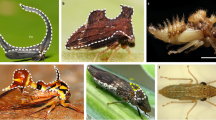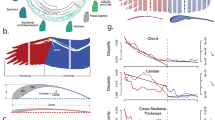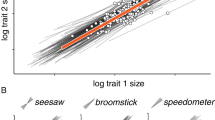Abstract
Evolutionary developmental biology has encouraged a change of research emphasis from the sorting of phenotypic variation by natural selection to the production of that variation through development1. Some morphologies are more readily generated than others, and developmental mechanisms can limit or channel evolutionary change2. Such biases determine how readily populations are able to respond to selection3, and have been postulated to explain stasis in morphological evolution4 and unexplored morphologies5. There has been much discussion about evolutionary constraints6,7,8 but empirical data testing them directly are sparse9,10. The spectacular diversity in butterfly wing patterns11 is suggestive of how little constrained morphological evolution can be. However, for wing patterns involving serial repeats of the same element, developmental properties suggest that some directions of evolutionary change might be restricted12,13. Here we show that despite the developmental coupling between different eyespots in the butterfly Bicyclus anynana, there is great potential for independent changes. This flexibility is consistent with the diversity of wing patterns across species and argues for a dominant role of natural selection, rather than internal constraints, in shaping existing variation.
This is a preview of subscription content, access via your institution
Access options
Subscribe to this journal
Receive 51 print issues and online access
$199.00 per year
only $3.90 per issue
Buy this article
- Purchase on Springer Link
- Instant access to full article PDF
Prices may be subject to local taxes which are calculated during checkout



Similar content being viewed by others
References
Stern, D. L. Perspective: Evolutionary developmental biology and the problem of variation. Evolution 54, 1079–1091 (2000).
Maynard-Smith, J. et al. Developmental constraints and evolution. Q. Rev. Biol. 60, 265–287 (1985).
Wagner, G. P. The influence of variation and development constraints on the rate of multivariate phenotypic evolution. J. Evol. Biol. 1, 45–66 (1988).
Williamson, P. G. in Rates of Evolution (eds Campbell, K. S. W. & Day, M. F.) (Allen & Unwin, London, 1987).
Gould, S. J. A developmental constraint in Cerion, with comments on the definition and interpretation of constraint in evolution. Evolution 43, 516–539 (1989).
Gould, S. J. & Lewontin, R. C. The spandrels of San Marco and the Panglossian paradigm: a critique of the adaptationist programme. Proc. R. Soc. Lond. B 205, 581–598 (1979).
Antonovics, J. & van Tienderen, P. H. Ontocogenophyloconstraints? The chaos of constraint terminology. Trends Ecol. Evol. 6, 166–168 (1991).
Pigliucci, M. & Kaplan, J. The fall and rise of Dr Pangloss: adaptationism and the Spandrels paper 20 years later. Trends Ecol. Evol. 15, 66–70 (2000).
Travisano, M. Mongold, J. A., Bennett, A. F. & Lenski, R. E. Experimental tests of the role of adaptation, chance, and history in evolution. Science 267, 87–90 (1995).
Teotónio, H. & Rose, M. R. Variability in the reversibility of evolution. Nature 408, 463–466 (2000).
Nijhout, H. F. The Development and Evolution of Butterfly Wing Patterns (Smithsonian Inst. Press, Washington, 1991).
Brakefield, P. M. The evolution–development interface and advances with the eyespot patterns in Bicyclus butterflies. Heredity 80, 265–272 (1998).
Brakefield, P. M. Structure of a character and the evolution of butterfly eyespot patterns. J. Exp. Zool. 291, 93–104 (2001).
Nijhout, H. F. Symmetry systems and compartments in lepidopteran wings—the evolution of a patterning mechanism. Development (Suppl.) 225–233 (1994).
Paulsen, S. & Nijhout, H. F. Phenotypic correlation structure among elements of the color pattern in Precis coenia (Lepidoptera, Nymphalidae). Evolution 47, 593–618 (1993).
Monteiro, A. F., Brakefield, P. M. & French, V. The evolutionary genetics and developmental basis of wing pattern variation in the butterfly Bicyclus anynana. Evolution 48, 1147–1157 (1994).
Cheverud, J. M. Quantitative genetics and developmental constraints on evolution by selection. J. Theor. Biol. 110, 155–171 (1984).
Paulsen, S. M. Quantitative genetics of butterfly wing color patterns. Dev. Genet. 15, 79–91 (1994).
French, V. & Brakefield, P. M. Eyespot development on butterfly wings: the focal signal. Dev. Biol. 168, 112–123 (1995).
Brakefield, P. M. et al. Development, plasticity and evolution of butterfly eyespot patterns. Nature 384, 236–242 (1996).
Brunetti, C. et al. The generation and diversification of butterfly eyespot color patterns. Curr. Biol. 11, 1578–1585 (2001).
Beldade, P., Brakefield, P. M. & Long, A. D. Contribution of Distal-less to quantitative variation in butterfly eyespots. Nature 415, 315–318 (2002).
Monteiro, A. F., Brakefield, P. M. & French, V. Butterfly eyespots: the genetics and development of the color rings. Evolution 51, 1207–1216 (1997).
Scharloo, W. in Organisational Constraints on the Dynamics of Evolution (eds Vida, G. & Maynard-Smith, J.) 197–210 (Manchester Univ. Press, 1983).
Weber, K. E. How small are the smallest selectable domains of form? Genetics 130, 345–353 (1992).
Zar, J. H. Biostatistical Analysis (Prentice Hall, Upper Saddle River, 1999).
Roff, D. A. Evolutionary Quantitative Genetics (Chapman & Hall, New York, 1999).
Nijhout, H. F. Independent development of homologous pattern elements in the wing patterns of butterflies. Dev. Biol. 108, 146–151 (1985).
Barton, N. & Partridge, L. Limits to natural selection. BioEssays 22, 1075–1084 (2000).
Condamin, M. Monographie du Genre Bicyclus (Lepidoptera, Satyridae) (Inst. Fond. Afr. Noire, Dakar, 1973).
Acknowledgements
We thank V. French, M. Matos, H. Metz, H. Teotónio, G. Wagner and B. Zwaan for helpful discussions about the experimental design, M. Lavrijsen, E. Schlatmann, B. de Winter and N. Wurzer for cultivating maize for hungry larvae, and V. French and H. Teotónio for comments on the manuscript. This work was supported by the Portuguese Foundation for Science and Technology under the Gulbenkian PhD Program (P.B.) and the Human Frontiers Science Program (P.M.B.).
Author information
Authors and Affiliations
Corresponding author
Ethics declarations
Competing interests
The authors declare that they have no competing financial interests
Rights and permissions
About this article
Cite this article
Beldade, P., Koops, K. & Brakefield, P. Developmental constraints versus flexibility in morphological evolution. Nature 416, 844–847 (2002). https://doi.org/10.1038/416844a
Received:
Accepted:
Issue Date:
DOI: https://doi.org/10.1038/416844a
This article is cited by
-
D’Arcy Thompson’s Morphological Transformations: Issues of Causality and Dimensionality
Biological Theory (2023)
-
Temperature sensitivity of Notch signaling underlies species-specific developmental plasticity and robustness in amniote brains
Nature Communications (2022)
-
A universal power law for modelling the growth and form of teeth, claws, horns, thorns, beaks, and shells
BMC Biology (2021)
-
Why call it developmental bias when it is just development?
Biology Direct (2021)
-
Metabolic growth hypothesis for the evolution of the nuchal hump in swordtail fishes
Environmental Biology of Fishes (2021)
Comments
By submitting a comment you agree to abide by our Terms and Community Guidelines. If you find something abusive or that does not comply with our terms or guidelines please flag it as inappropriate.



